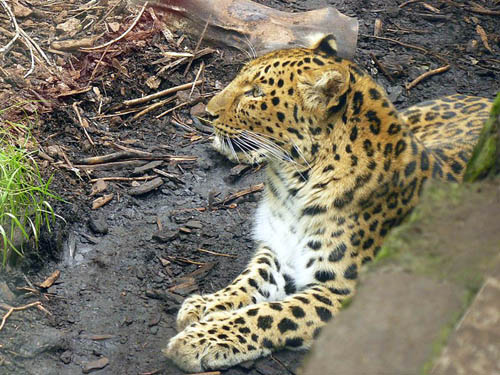VISITORS and animal welfare experts have criticised Edinburgh Zoo for its “heartbreaking” treatment of one of the world’s most endangered animals.
Seven-year-old Amur Leopard Skodje – one of only 200 left in the world – is the subject of complaints that he is constantly pacing in an enclosure measuring around 20ft wide and 30ft deep.
The big cat arrived at the zoo almost six years ago and was put in the enclosure as a “temporary” measure while a new home is built at the Highland Wildlife Park near Aviemore.
Critics of the zoo say there is still no sign of the new home being completed and Skodje’s pacing is a classic sign of distress.
Amur Leopards would normally roam areas of Siberia ranging in size from 19 to 120 square miles.

The leopards, which once lived in China and Korea as well as Russia, are among the most endangered creatures in the world.
There are thought to be as few as 14-20 adults left in the wild and 176 in captivity.
Their dramatic decline is mainly due to poaching of both leopards and their prey animals, habitat destruction due to human activity, and inbreeding.
Visitors to the zoo have left online comments criticising the institution over the size of Skodje’s enclosure, which he has shared with female Zane since 2009.
One visitor from Fife said: “Some of the animal enclosures seem very cramped and it was particularly upsetting to witness the constant pacing of the beautiful Amur leopard. Definitely not the sign of a contented animal.”
Another tourist, from Dundee, said she had first noticed the Leopard’s pacing two years ago.
She said: “I visited two years ago when my oldest child was six and my youngest a few months old. When we were there, I was so saddened to see a beautiful leopard pacing a tiny glass enclosure while people stared and took pictures, this seemed to be the case for most of the big cats.
“We recently went back and nothing had changed, the leopard was still pacing the box, tracing its own footsteps, while being stared at by us humans. It was heartbreaking.”
One online reviewer, from Dorset, said: “The Amur Leopard was pacing up and down at the front of his enclosure, which was heartbreaking to see. His enclosure was very small for such a large and active animal.”
Another tourist, from Oxford, described seeing the leopard’s enclosure as “the saddest experience” of her life.
Pacing
A spokeswoman for animal welfare charity OneKind said: “Unfortunately pacing is stereotypical behaviour for an animal in distress.
“It is incredibly sad to hear about this leopard just walking back and forwards, it is very depressing. It is a wild animal with a minute enclosure.”
Scottish SPCA Chief Superintendent Mike Flynn said they had been assured by the zoo that the leopards had enough space and “environmental stimulus to prevent any suffering or distress”.
Mr Flynn added: “Unfortunately, animals kept in captivity can display behaviour such as pacing.”
Mecedes the Polar Pair spent the last two years of her life at Aviemore’s Highland Wildlife Park following a lifetime in captivity at Edinburgh Zoo.
The polar bear was captured in the wild in Canada in 1984 and re-located to the Zoo. Despite her popularity with tourists, animal rights campaigners repeatedly criticised her cramped living conditions and regular pacing.
Darren McGarry, Head of Living Collections at Edinburgh Zoo, said: “The behaviour being displayed by the Amur leopards, including pacing, is normal, natural behaviour that would be seen in the wild as they patrol their territories.
“The welfare of our animals is extremely important to us at Edinburgh Zoo and while we cannot replace their habitat in the wild, we can ensure the animals in our collection have everything they need to lead a safe, healthy and fulfilling life.
Wellbeing
“Our keepers are committed to ensuring the animals’ wellbeing and contribute to this by carrying out extensive animal enrichment to ensure they are stimulated.
“There are plans for the Amur leopards to move to another zoo or collection as part of the conservation breeding programme.”
A spokeswoman at the Zoo said they still had not set a date for the Leopard’s move to the Highland Park in Aviemore.
She added: “We are still waiting to hear back about that.”
Despite criticism, Edinburgh Zoo appears to have enjoyed a bumper 2012 on the back of the pandas.
The tourist destination was named second in a list of the Top 20 paid-for visitors attractions in Edinburgh last year, with a footfall of 810,937 visitors – up from 535,573 the year before.
However not everyone is happy. On TripAdvisor one visitor lamented the lack of animals, writing: “we didn’t see very many animals – a lot of cages were empty.”

